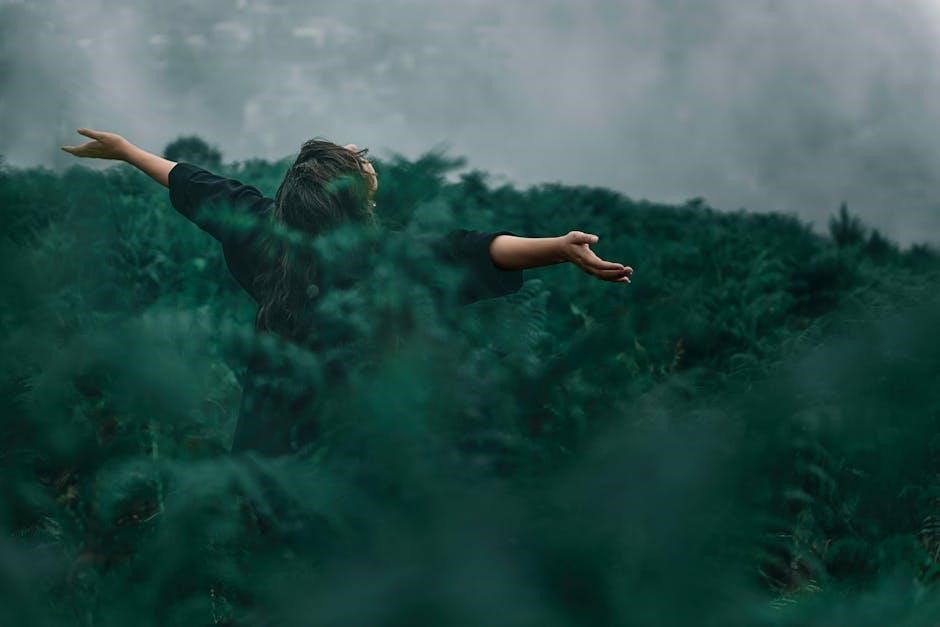Discover the world of watercolor painting with free tutorials perfect for all skill levels․ Learn essential techniques, from basic brush strokes to advanced color mixing, through accessible online resources․
1․1 Overview of Watercolor Painting
Watercolor painting is a versatile and expressive medium characterized by its transparency and fluidity․ It involves using water-soluble pigments on paper, creating delicate washes and vibrant colors․ Unlike other painting techniques, watercolor relies on the paper’s absorbency, making it both challenging and rewarding․ Artists can achieve a range of effects, from soft, dreamy landscapes to detailed, realistic compositions․ Watercolor is popular among artists of all skill levels due to its accessibility and the ability to produce stunning results with minimal equipment․ For beginners, free tutorials offer a great way to learn fundamental techniques, such as brush control, color mixing, and layering․ These resources often include step-by-step guides, making it easier to master the basics and build confidence in this beautiful art form․
1․2 Importance of Free Resources for Beginners
Free watercolor resources are invaluable for beginners, offering accessible learning tools without financial barriers․ These tutorials provide step-by-step guidance, helping new artists build foundational skills like brush control and color mixing․ They also foster creativity and confidence, allowing learners to experiment without pressure․ Many free resources, such as YouTube videos and online courses, are designed specifically for newcomers, breaking down complex techniques into manageable lessons․ Additionally, these resources often include tips for fixing mistakes and improving consistency, making the learning process less intimidating․ By leveraging free tutorials, beginners can explore watercolor painting, discover their style, and gradually refine their craft without initial investment, making it an ideal starting point for artistic exploration and growth․
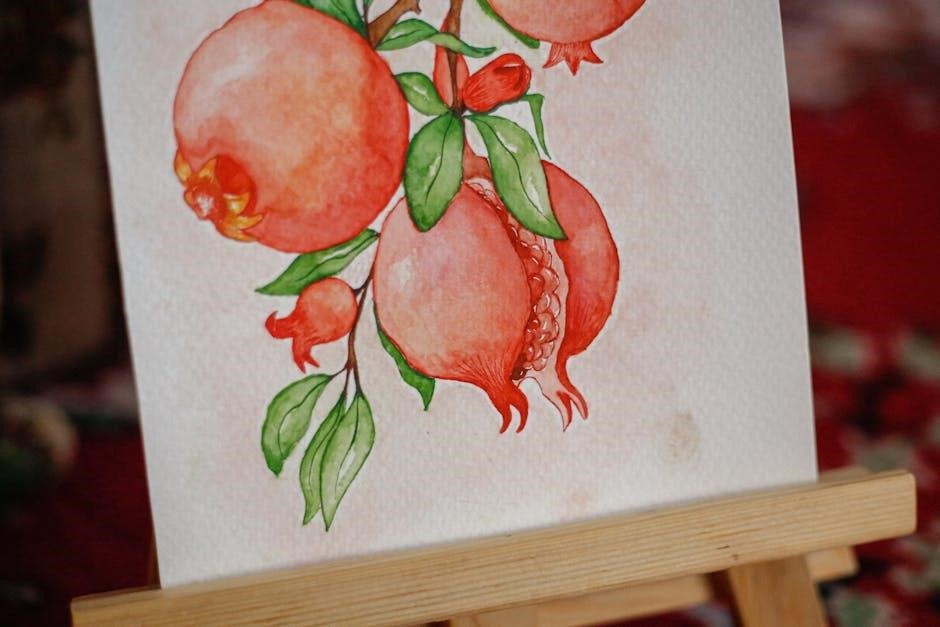
Best YouTube Channels for Watercolor Tutorials
Explore top YouTube channels offering free watercolor tutorials, such as Shibasaki, Kirsty Partridge, and Louise de Masi, providing step-by-step guidance for all skill levels and styles․
2․1 Shibasaki’s Watercolor Tutorials
Shibasaki’s watercolor tutorials are highly regarded for their clarity and creativity․ Her channel offers a wide range of lessons, from basic techniques to intricate designs, making it ideal for both beginners and experienced artists․ Shibasaki’s calm and soothing teaching style creates a relaxing learning environment, allowing viewers to focus on mastering watercolor fundamentals․ She covers topics like brush control, color mixing, and wet-on-wet techniques, often incorporating beautiful floral and animal designs․ Her tutorials are free, accessible, and perfect for those looking to improve their skills without spending money․ With her step-by-step guidance, artists can confidently explore watercolor painting and bring their creative visions to life․
2․2 Kirsty Partridge’s Art Lessons
Kirsty Partridge’s watercolor tutorials are a fantastic resource for artists of all levels․ Her channel, “Let’s Make Art,” offers a wide variety of lessons, from basic techniques to more complex projects․ Kirsty’s teaching style is friendly and encouraging, making her tutorials feel like a fun, creative journey․ She covers essential skills such as brush control, color mixing, and composition, while also sharing tips for fixing mistakes and organizing your art supplies․ Her lessons often focus on painting landscapes, florals, and animals, providing plenty of inspiration for learners․ Kirsty’s tutorials are free, accessible, and perfect for those looking to improve their watercolor skills in a supportive and creative environment․ Her emphasis on experimentation and creativity makes her lessons both educational and enjoyable․
2․3 Louise de Masi’s Flower and Animal Tutorials
Louise de Masi’s watercolor tutorials are a treasure trove for artists passionate about painting flowers and animals․ Her lessons are detailed and easy to follow, making them ideal for both beginners and intermediate learners․ Louise specializes in capturing the delicate beauty of botanical subjects and the charm of wildlife, offering step-by-step guidance on techniques like layering, blending, and texture creation․ Her tutorials often focus on specific projects, such as painting roses, birds, or forest scenes, providing learners with clear goals and inspiration․ While her content is geared toward those with some basic watercolor knowledge, her calm and encouraging teaching style makes her tutorials accessible to all․ Louise’s work is a great resource for anyone looking to refine their skills in floral and animal watercolor painting․
2․4 Anna Mason’s Online School
Anna Mason’s Online School offers a wealth of free watercolor tutorials designed to help artists of all levels refine their skills․ Her lessons are structured to build confidence and technique, focusing on foundational principles like color theory, brush control, and composition․ With a emphasis on step-by-step guidance, Anna’s tutorials are particularly beneficial for beginners, though experienced artists will also find value in her detailed approach․ She covers a wide range of subjects, from delicate florals to serene landscapes, providing learners with diverse projects to practice․ Anna’s teaching style is encouraging and clear, making complex techniques feel achievable․ Her free resources are a fantastic starting point for anyone looking to improve their watercolor skills without investing in paid courses․
2․5 In Liquid Color’s Beginner Tips
In Liquid Color’s channel is a fantastic resource for watercolor enthusiasts, offering a variety of free tutorials and tips tailored for beginners․ Her content focuses on essential techniques, such as basic brush strokes, color mixing, and wet-on-wet methods, all explained in a clear and approachable manner․ One of her standout videos, “Beginner Tips for Starting with Watercolor,” provides a comprehensive guide for those just picking up a brush․ She also shares practical advice on choosing the right materials and maintaining a clean, organized workspace․ Additionally, her reviews of watercolor paints and journals help learners make informed decisions․ With her encouraging tone and step-by-step demonstrations, In Liquid Color makes watercolor painting accessible and enjoyable for everyone․
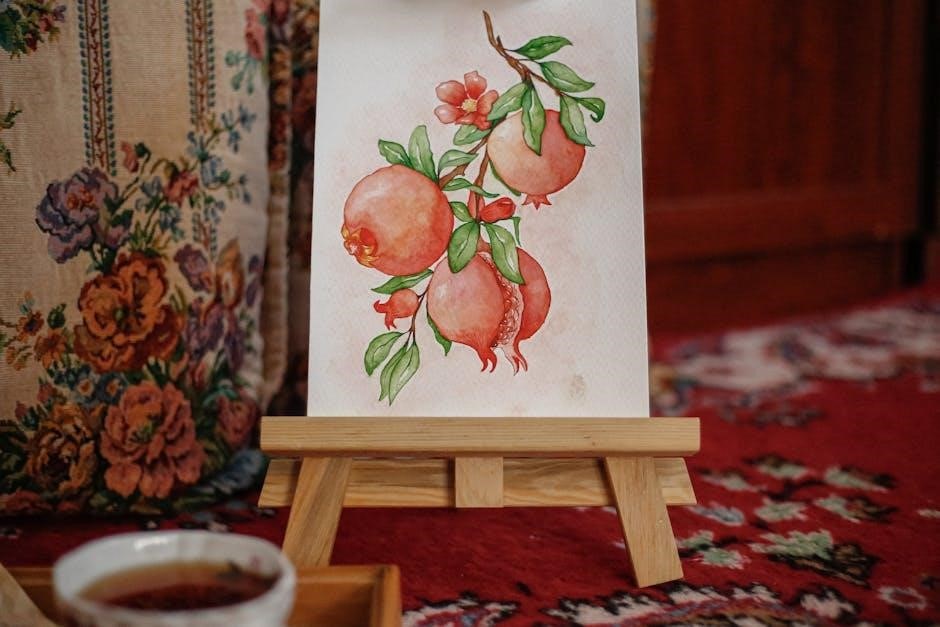
Essential Watercolor Techniques
Master foundational watercolor techniques like wet-on-wet, wet-on-dry, brush control, and color theory․ These methods are crucial for creating vibrant, layered artworks and achieving desired effects in your paintings․
3․1 Basic Brush Strokes and Control
Mastering basic brush strokes is fundamental to watercolor painting․ Start with flat washes for broad areas, round brushes for details, and mop brushes for soft textures․ Practice loading your brush with the right amount of paint and water to achieve consistent strokes․ Learn to control pressure and angle to vary line widths․ Wet-on-wet techniques require smooth, even strokes, while drybrushing adds texture․ Regular practice with simple exercises, like painting color charts, helps build muscle memory and precision․ Understanding how to maintain a wet edge is key for blending and preventing hard lines; These foundational skills will enhance your ability to execute more complex techniques with confidence and precision in your watercolor journey․
3․2 Color Theory and Mixing Basics
Understanding color theory is essential for mastering watercolor․ Start with the basics of the color wheel, exploring primary and secondary colors․ Learn how to mix warm and cool hues to create harmonious palettes․ Discover the difference between tints, tones, and shades by adding white, gray, or black to your colors․ Practice creating color charts to see how pigments interact․ Experiment with a limited palette to simplify mixing and achieve consistent results․ Free tutorials often emphasize the importance of clean color filling and maintaining wet edges for smooth transitions․ These foundational skills will help you control color flow and saturation, ensuring vibrant, balanced compositions in your watercolor art․
3․3 Wet-on-Wet and Wet-on-Dry Techniques
Mastering wet-on-wet and wet-on-dry techniques is crucial for achieving desired effects in watercolor․ Wet-on-wet involves adding pigment to damp paper, creating soft blends and fluid transitions․ This method is ideal for skies, backgrounds, and subtle gradations․ Wet-on-dry, on the other hand, involves painting onto dry paper, offering crisp edges and vibrant colors, perfect for details and defined shapes․ Free tutorials often demonstrate these techniques with step-by-step examples, emphasizing the importance of timing and paper moisture․ Practice these methods to enhance your control over color and texture, allowing you to create dynamic, layered compositions with ease and confidence in your watercolor journey․
3․4 Clean Color Filling and Wet Edge Maintenance
Clean color filling and wet edge maintenance are essential techniques for smooth, even watercolor applications․ Clean color filling involves applying clean water to an area before adding pigment, ensuring vibrant, un-muted colors․ Wet edge maintenance prevents hard lines by keeping edges moist, allowing colors to blend naturally․ Free tutorials often highlight these methods, demonstrating how to achieve seamless transitions and avoid unwanted textures․ Practice these techniques to refine your control over color placement and layering, enhancing the fluidity and professionalism of your watercolor work․ These skills are fundamental for creating cohesive, visually appealing compositions in any watercolor project․
Recommended Websites and Blogs
Explore top websites and blogs offering free watercolor tutorials, resources, and creative guides․ Doodlewash, Watercolor Corner, and Jenna Rainey provide inspiring challenges and expert tips for learners․
4․1 Doodlewash Art Challenges
Doodlewash offers monthly art challenges with daily prompts, ideal for watercolor enthusiasts․ These exercises help build confidence and creativity while refining techniques․ Participants receive a list of themes, encouraging consistent practice and experimentation․ The challenges foster a supportive community, where artists share their work and gain feedback․ Many beginners have seen significant improvement by committing to these prompts․ The structured approach helps develop discipline and inspiration, making it easier to stay motivated․ Whether you’re exploring new styles or honing existing skills, Doodlewash’s challenges provide a fun and engaging way to grow as a watercolor artist․ Their resources are free, making them accessible to everyone․
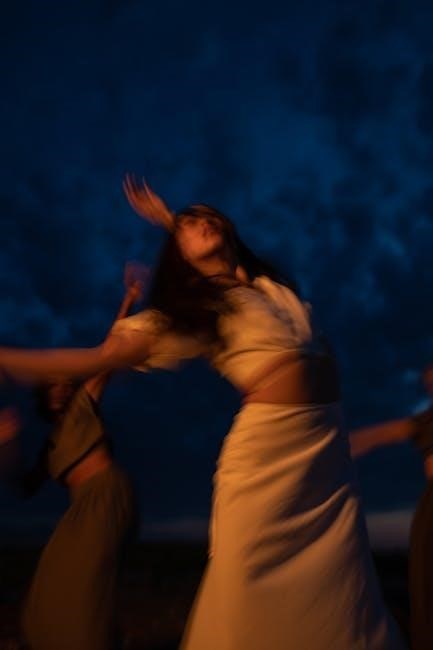
4․2 Watercolor Corner’s Resource Roundup
Watercolor Corner offers a comprehensive roundup of free resources for watercolor enthusiasts․ Their curated list includes top YouTube channels, tutorials, and tips for mastering watercolor techniques․ Whether you’re a beginner or an advanced artist, their roundup provides valuable insights and inspiration․ They also feature product reviews and recommendations, helping you choose the best materials․ The platform is a go-to destination for anyone looking to improve their skills without spending money․ By exploring their roundup, you can discover new artists, learn fresh techniques, and stay updated on the latest trends in watercolor painting․ Their community-driven approach makes learning fun and accessible for everyone․
4․3 Jenna Rainey’s Creative Guides
Jenna Rainey’s creative guides are a treasure trove for watercolor enthusiasts․ Her resources include step-by-step tutorials, traceable outlines, and reference photos, making learning accessible for all skill levels․ Rainey’s approach combines humor and inspiration, encouraging artists to embrace creativity and practice consistently․ Her tutorials often focus on painting flowers, landscapes, and other popular subjects, providing clear instructions for achieving stunning results․ Additionally, she offers a free email newsletter packed with tips and resources, helping artists stay motivated and improve their skills․ Rainey’s guides are particularly praised for their structured yet flexible approach, allowing learners to grow at their own pace while exploring the beauty of watercolor painting․
Free Online Courses and Classes
Explore free watercolor courses on platforms like Skillshare, Terry Madden’s workshop, and Deb Watson’s lessons․ These resources offer structured learning, video demos, and step-by-step guidance for all skill levels․
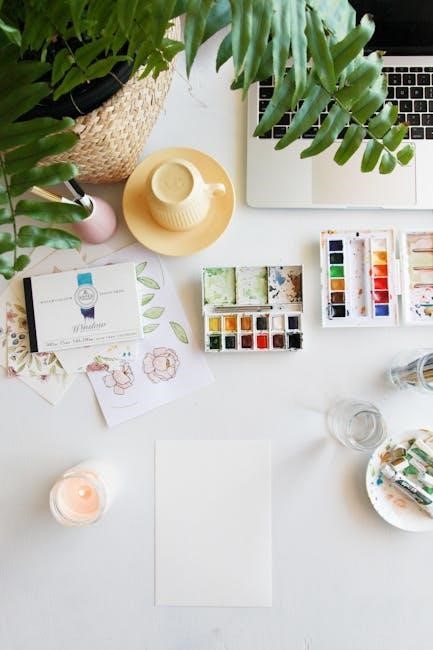
5․1 Skillshare’s Watercolor Classes
Skillshare offers a wide range of free watercolor classes designed for both beginners and intermediate learners․ These classes provide a structured approach to learning watercolor techniques, covering topics such as basic brush strokes, color theory, and project-based lessons․ Many courses are available for free, allowing you to explore the medium without financial commitment․ Instructors are experienced artists who share practical tips and demonstrate techniques step-by-step․ Classes often include downloadable resources, such as color charts and practice sheets, to enhance your learning experience․ Skillshare’s platform is user-friendly, enabling you to learn at your own pace․ Whether you’re interested in painting florals, landscapes, or abstract art, Skillshare’s watercolor classes offer a comprehensive and engaging way to improve your skills․ Start your creative journey today and unlock the possibilities of watercolor painting with these accessible and informative courses․
5․2 Terry Madden’s Watercolor Workshop
Terry Madden’s Watercolor Workshop is a fantastic resource for free watercolor tutorials․ By signing up for his free email subscription, you gain access to weekly videos that cover a variety of watercolor techniques․ Each video is approximately 35 minutes long and focuses on different aspects of watercolor painting, from basic skills to more advanced methods․ Terry’s approach is clear and informative, making it easy for beginners to follow along․ The workshop is designed to help artists improve their skills gradually, with each lesson building on the previous one․ Whether you’re interested in painting landscapes, florals, or abstract art, Terry’s tutorials provide valuable insights and practical tips․ This structured learning approach makes it an excellent choice for those looking to enhance their watercolor abilities without cost․
5․3 Deb Watson’s Step-by-Step Lessons
Deb Watson’s step-by-step lessons are a treasure trove for watercolor enthusiasts․ She offers free, detailed tutorials that guide learners through various techniques, from basic to advanced․ Each lesson is accompanied by traceable outline pages, reference photos, and demo videos, making it easy for beginners to follow․ Deb’s approach is patient and encouraging, allowing artists to build confidence as they progress․ Her lessons cover a range of subjects, including florals, landscapes, and more․ With a focus on practical tips and clear instructions, Deb Watson’s resources are ideal for anyone looking to improve their watercolor skills․ Her lessons are accessible online, providing a wealth of knowledge for free․ This makes her tutorials a valuable resource for both new and experienced artists alike․
Books and eBooks for Watercolor Learning
Explore watercolor techniques through free eBooks and books like “Everyday Watercolor” by Jenna Rainey․ These resources offer step-by-step guides and tips for mastering watercolor painting at no cost․
6․1 “Everyday Watercolor” by Jenna Rainey
“Everyday Watercolor” by Jenna Rainey is a best-selling guide offering a structured approach to learning watercolor․ This book is perfect for beginners and experienced artists alike, providing clear instructions and inspiring projects; Rainey shares her expertise through step-by-step tutorials, covering essential techniques like brush control, color mixing, and composition․ The book emphasizes foundational skills, allowing artists to build confidence and creativity․ With a focus on practical lessons, “Everyday Watercolor” helps artists progress from simple exercises to more complex pieces․ Rainey’s engaging teaching style and encouragement make this resource a favorite among watercolor enthusiasts․ It’s a must-have for anyone looking to improve their skills in a structured and enjoyable way, making it a valuable addition to your watercolor learning journey․
6․2 Free eBooks on Watercolor Basics
Free eBooks on watercolor basics are an excellent resource for beginners and intermediate artists․ These eBooks often cover fundamental techniques, color theory, and practical exercises to help you improve your skills․ Many artists, like Jenna Rainey, offer free downloadable guides on their websites, providing step-by-step instructions and tips for mastering watercolor․ These resources are perfect for those who prefer self-paced learning or need a refresher on specific techniques․ Topics typically include brush control, wet-on-wet methods, and essential supplies․ By exploring these free eBooks, you can gain valuable insights and confidence in your watercolor journey without spending a dime․ They’re a great way to supplement your learning and keep your creativity flowing․
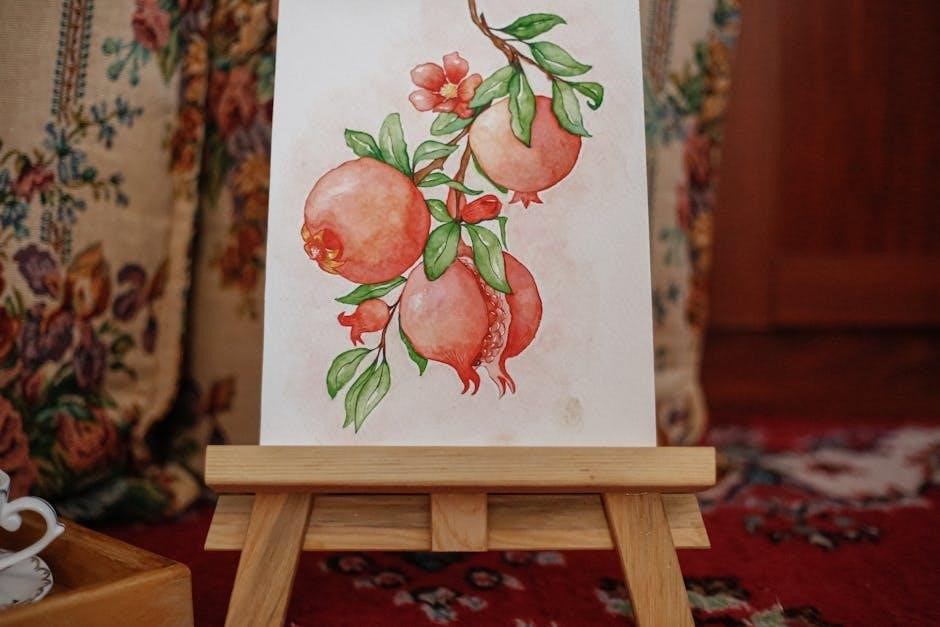
Practice Routines for Consistent Improvement
Consistency is key to improving watercolor skills․ Set up a daily practice schedule and commit to regular sessions, even if brief․ Tracking progress and staying dedicated leads to steady growth and confidence in your artistic abilities․
7․1 Setting Up a Daily Practice Schedule

Establishing a daily practice routine is essential for consistent improvement in watercolor painting․ Dedicate a specific time each day, even if brief, to focus on painting․ Start with short sessions, such as 15–30 minutes, and gradually increase as your routine becomes more comfortable․ Use a timer to maintain focus and avoid distractions․ Vary your exercises to cover different techniques, such as brush strokes, color mixing, and wet-on-wet methods․ Incorporate warm-up sketches or simple compositions to build confidence․ Track your progress by journaling or photographing your work․ Consistency, rather than the duration, is key to developing skills and staying motivated․ Make practice a habit to enjoy steady growth in your watercolor journey․
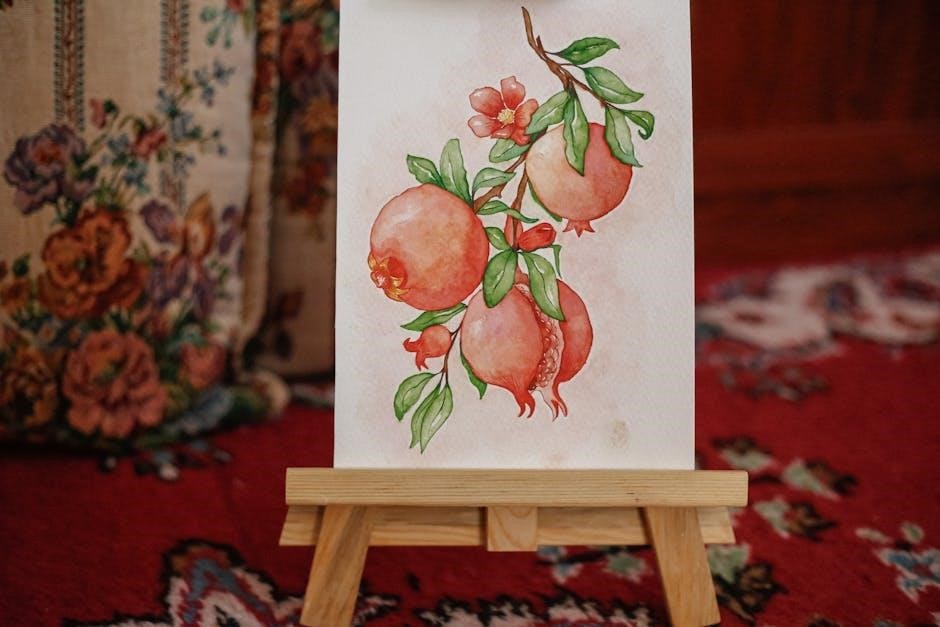
7․2 The Role of Consistency in Skill Development
Consistency is the cornerstone of skill development in watercolor painting․ Regular practice, even for short periods, helps build muscle memory and improves technique․ Over time, consistent effort leads to noticeable progress, as repetitive exercises refine brush control and color mixing abilities․ It fosters a deeper understanding of the medium, allowing artists to anticipate how water and pigment interact․ Consistency also cultivates creativity, as familiarity with tools and techniques enables exploration of new styles․ By committing to regular practice, learners can overcome challenges and stay motivated․ Ultimately, consistency transforms watercolor painting from a daunting task into a enjoyable, rewarding journey of artistic growth and self-expression․
Common Mistakes to Avoid
Avoid over-saturating paper, as it leads to buckling and uneven drying․ Incorrect brush loading can result in poor color flow and unintended textures, hindering your artistic goals․
8․1 Over-Saturating the Paper
Over-saturating the paper is a common mistake that can lead to buckling, uneven drying, and even tearing․ This occurs when too much water or paint is applied, weakening the paper’s structure․ To avoid this, use a spray bottle to dampen the paper instead of soaking it․ Always allow previous layers to dry before adding more washes․ Start with light, gentle strokes and gradually build up color․ Using high-quality, heavy-weight paper designed for watercolor can also help withstand multiple layers without buckling․ By controlling the amount of water and paint, you maintain the paper’s integrity and achieve smoother, more professional results in your watercolor journey․
8․2 Incorrect Brush Loading Techniques
Incorrect brush loading is a common mistake that can lead to uneven paint application and a messy finish․ To avoid this, dip your brush in clean water first, then tap off excess before picking up paint from your palette․ Avoid overloading the brush with too much paint, as this can cause difficulty in controlling strokes․ Instead, load the brush evenly, ensuring the paint reaches the ferrule but doesn’t clump․ Practice loading different brush sizes to understand their capacity․ Testing the brush on scrap paper can help gauge if it’s properly loaded․ Proper brush loading enhances precision, allowing for smoother transitions and cleaner washes in your watercolor work․
Specific Project Tutorials
Explore step-by-step guides for painting simple florals, creating dreamy landscapes, and mastering flower compositions․ These tutorials offer clear instructions for achieving stunning results in watercolor art․
9․1 Painting Simple Florals
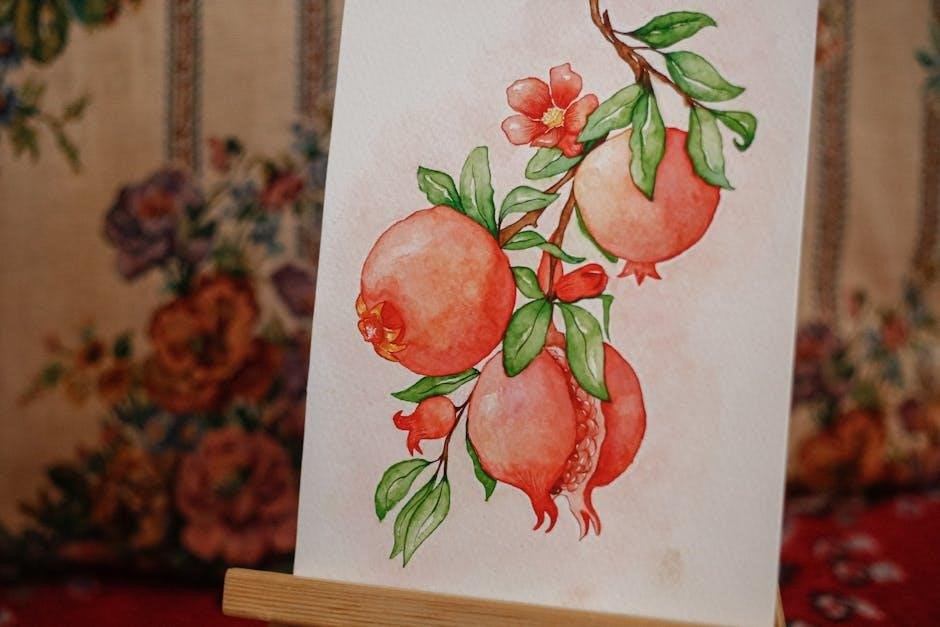
Master the art of painting simple yet vibrant florals with free tutorials designed for beginners․ Learn to capture the delicate beauty of flowers using basic watercolor techniques․ Start with simple shapes and gradual color transitions to create realistic petals․ Tutorials often include step-by-step demonstrations for painting popular flowers like roses, lavender, and sunflowers․ Discover how to layer washes for soft textures and blend colors for natural hues․ Many tutorials also cover essential tips, such as maintaining wet edges and avoiding over-saturation․ Practice these techniques to build confidence and improve your ability to depict floral compositions with ease․ These lessons are perfect for those looking to explore watercolor’s expressive qualities while creating charming floral art․
9․2 Creating Dreamy Landscapes
Unleash your creativity with free tutorials that guide you in crafting ethereal, dreamy landscapes using watercolor․ Learn to blend soft gradients and ethereal skies, creating a sense of depth and atmosphere․ Discover techniques like wet-on-wet and glazing to achieve soft, luminous effects․ Tutorials often focus on painting misty mountains, serene water reflections, and subtle foliage․ Practice using gentle brushstrokes to suggest rather than define, allowing the water to flow naturally․ These lessons emphasize minimal detail to evoke a sense of calm and mystery․ Explore how to balance warm and cool tones for a harmonious palette․ With these tips, you can create captivating landscapes that inspire tranquility and imagination, perfect for beginners looking to explore watercolor’s expressive potential․
9․3 Step-by-Step Flower Painting
Master the art of painting vibrant flowers with free, step-by-step watercolor tutorials․ Learn to capture the delicate petals and intricate details of blooms like roses, sunflowers, and lavender․ Tutorials guide you through selecting brushes, mixing colors, and layering washes to achieve lifelike textures․ Discover how to paint soft gradients for petals and use wet-on-wet techniques for blending․ Many lessons include traceable outlines and reference images to help you practice․ From simple daisies to complex peonies, these tutorials break down each step, making it easy to follow along․ With practice, you’ll create stunning, detailed flower paintings that showcase your growing skills in watercolor art․
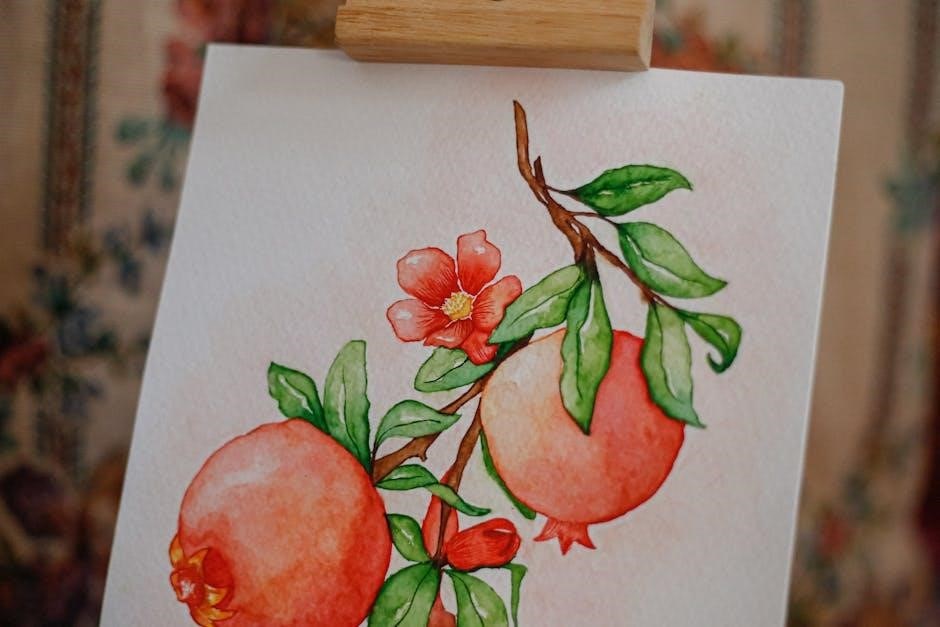
Inspiration and Communities
Foster creativity by following watercolor artists on Instagram and joining online communities․ Engage with fellow painters, share work, and gain inspiration from diverse styles and techniques․
10․1 Following Artists on Instagram
Instagram is a vibrant platform for watercolor enthusiasts, offering endless inspiration and a chance to discover diverse artistic styles․ By following watercolor artists, you can explore various techniques, from delicate florals to expansive landscapes․ Many artists share step-by-step snippets, time-lapse videos, and tips, providing valuable insights into their creative processes․ This exposure can help you develop your own unique style and stay motivated․ Additionally, engaging with these artists and their communities fosters a sense of connection and growth․ Platforms like Instagram also feature accounts dedicated to watercolor challenges and tutorials, making it easier to learn and improve․ Regularly browsing these accounts can spark new ideas and keep your artistic journey fresh and exciting․
10․2 Engaging with Online Watercolor Communities
Engaging with online watercolor communities is a fantastic way to connect with fellow artists, gain inspiration, and learn new techniques․ Platforms like Facebook groups, Reddit forums, and specialized art communities offer spaces to share your work, receive feedback, and participate in challenges․ Many communities host live painting sessions, Q&A threads, and collaborative projects, fostering a sense of camaraderie and growth․ These groups often share free resources, such as tutorials, brushes, and tips, making them invaluable for beginners․ By actively participating, you can stay motivated, learn from others, and refine your skills in a supportive environment․ Joining these communities also provides access to diverse perspectives and styles, helping you develop your unique artistic voice․
